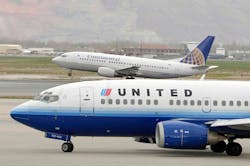The U.S. Department of Transportation's Bureau of Transportation Statistics issued the following news release:
Scheduled passenger airlines reported a profit margin of 6.8 percent in the third quarter of 2011, down from the 10.4 percent profit margin in the third quarter of 2010, BTS reported today in a release of preliminary data (Table 1).
BTS, a part of the Research and Innovative Technology Administration, reported that the network airlines reported an operating profit margin of 7.1 percent as a group in the July-to-September 2011 period. The low-cost group's profit margin was 6.0 percent, and the regional group's was 2.5 percent (Table 1). See Airline Financial Data Press Releases for historic data.
As part of their third-quarter revenue, the airlines collected $898 million in baggage fees (Table 1A) and $603 million from reservation change fees (Table 1B) from July to September 2011.
In addition to baggage and reservation change fees, airlines reported ancillary revenue of $872 million from passengers and from other sources. This revenue category includes revenue from frequent flyer award program mileage sales and pet transportation fees (Table 1D). Total third quarter 2011 airline revenue from all ancillary sources that can be identified, including fees and frequent flyer sales was $2.381 billion, with Delta Air Lines reporting the most, $814 million (Table 1E).
Baggage fees and reservation change fees are the only ancillary fees paid by passengers that are reported to BTS as separate items. Other fees, such as revenue from seating assignments and on-board sales of food, beverages, pillows, blankets, and entertainment are reported in a different category with other items and cannot be identified separately.
The baggage and reservation change fees from passengers combined with ancillary revenue from other sources constituted 5.8 percent of the total revenue of the 27 carriers that reported receiving ancillary revenue. Spirit Airlines reported the largest percent of operating revenue from ancillary revenue of any carrier, 31.1 percent (Table 1F). For additional Miscellaneous Operating Revenue data, go to BTS Schedule P-1.2.
Operating Margins
The six network carriers posted a profit margin of 7.1 percent in the third quarter with a combined operating profit of $2.2 billion (Table 2). Compared to last year, in the third quarter of 2010, the network carriers reported a profit margin of 10.5 percent with a profit of $3.0 billion. See Table 1 in third-quarter 2010 press release.
The seven low-cost carriers reported a 6.0 percent profit margin, with profits of $408 million for the 12th consecutive profitable quarter (Table 3). The six regional airlines reported a 3.5 percent profit margin that included profits of $65 million (Table 4).
Operating margin measures profit or loss as a percentage of the airline's total operating revenue. The top three operating profit margins of the three carrier groups were reported by network carriers Alaska Airlines and United Airlines and low-cost carrier Spirit (Tables 2, 3). ExpressJet Airlines reported the top loss margin of any carrier (Table 4).
Network carriers operate a significant portion of their flights using at least one hub where connections are made for flights on a spoke system. Low-cost carriers are those that the industry recognizes as operating under a low-cost business model, with lower infrastructure and aircraft operating costs and with less reliance on the hub-and-spoke system. Regional carriers provide service from small cities, using primarily regional jets to support the network carriers' hub and spoke systems. The selected network, low-cost and regional groups consist of those airlines in each group with the highest reported operating revenue in the most recent complete calendar year.
For other third-quarter 2011 financial data with comparisons to previous quarters for carrier groups and for the largest network, low-cost and regional airlines, see the following tables:
Operating Profit/Loss Margins Tables 1-4
Baggage Fees Table 1A
Reservation Change Fees Table 1B
Fees Compared to Profit/Loss Table 1C
Miscellaneous Operating Revenue (frequent flyer award program mileage sales and pet transportation fees) Table 1D
Ancillary Revenue Table 1E
Ancillary Revenue Compared to Total Operating Revenue Table 1F
Fuel Costs Tables 5-8
Unit Costs Tables 9-12
Unit Revenues Tables 13-16
Passenger Revenue Yield Tables 17-20
For additional fee data, see tables for baggage fees and reservation change fees. For additional Miscellaneous Operating Revenue data, go to BTS Schedule P-1.2.
Reporting Notes
This release consists of domestic and international, or system, financial reports for the airlines. For additional revenue and operating profit/loss numbers, go to the BTS home page and use the links in the Airline Industry box.
Airline financial data from the third quarter of 2011 and previous quarters are posted on the BTS website. Data are compiled from quarterly financial and monthly traffic reports filed with BTS by commercial air carriers.
Financial and traffic data are preliminary and include data received by BTS as of Feb. 27. Revised carrier data and late data filings will be made available monthly on TranStats on the Monday following the second Tuesday of the month. Data are subject to revision.
Tables omitted, click here (http://www.bts.gov/press_releases/2012/bts011_12/html/bts011_12.html)
Contact: Dave Smallen, 202/366-5568
Copyright Targeted News Services
TNS gv51gv 120313-3803937 61GemaViana
Copyright 2012 Targeted News Service LLCAll Rights Reserved


